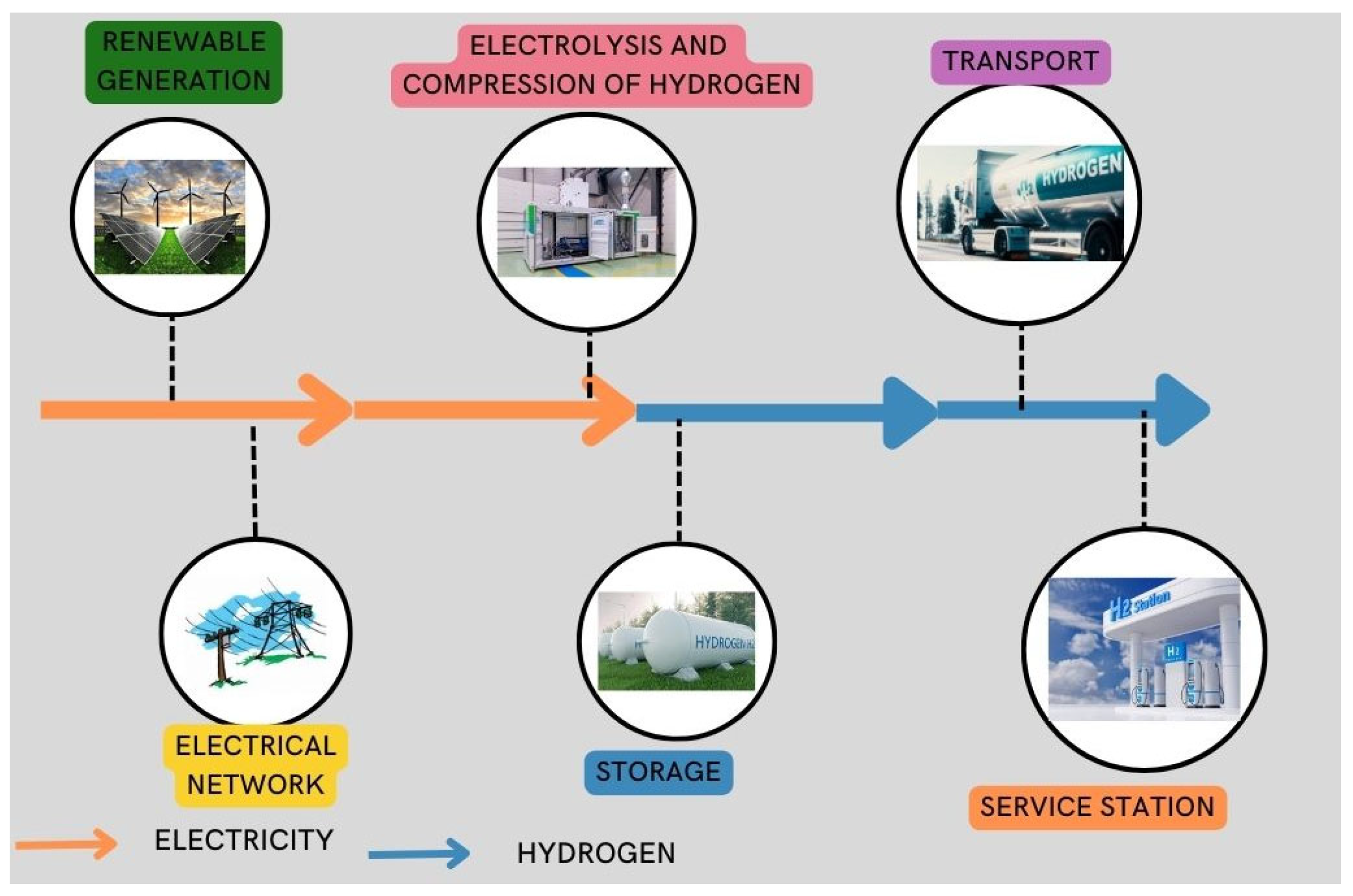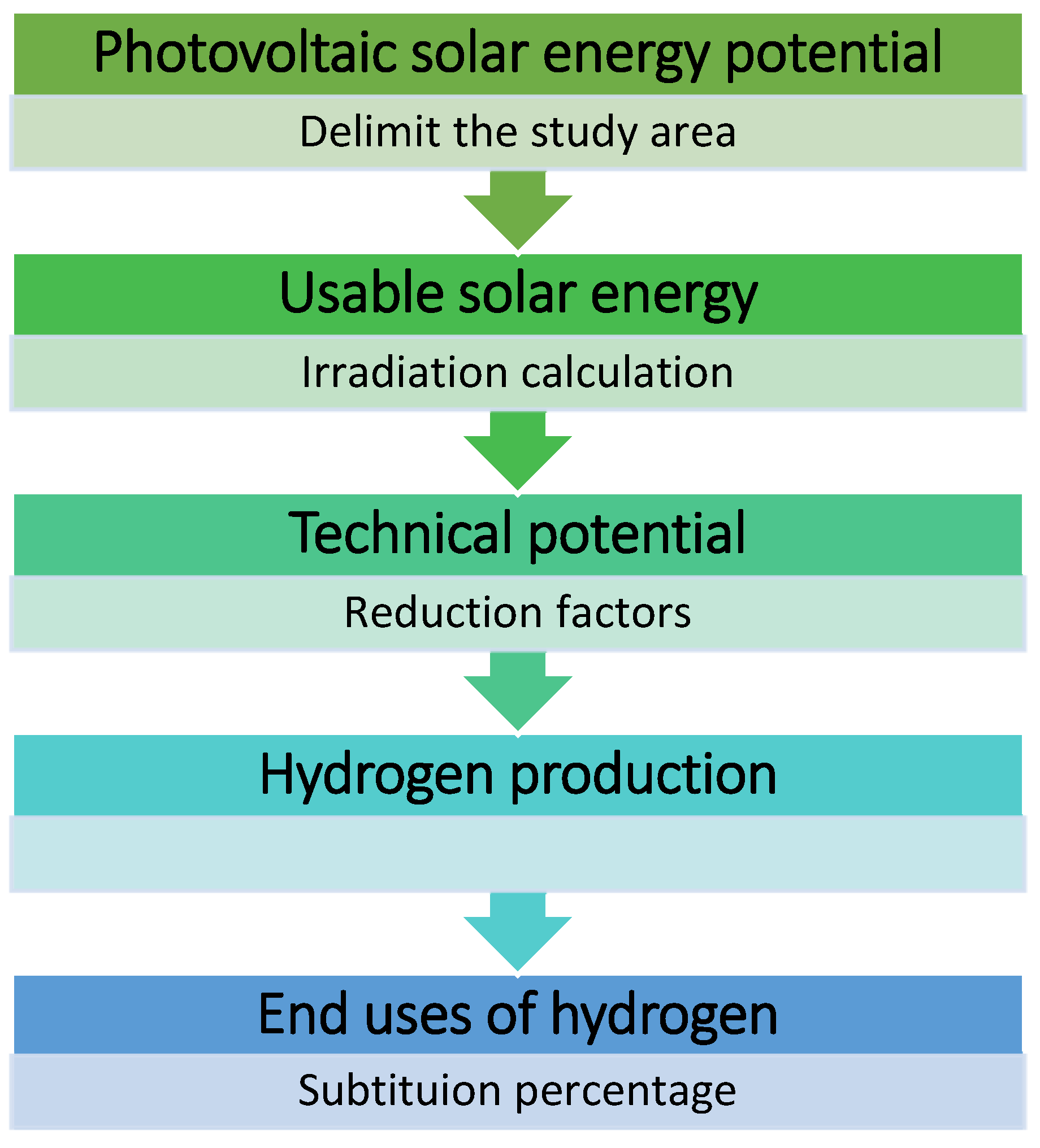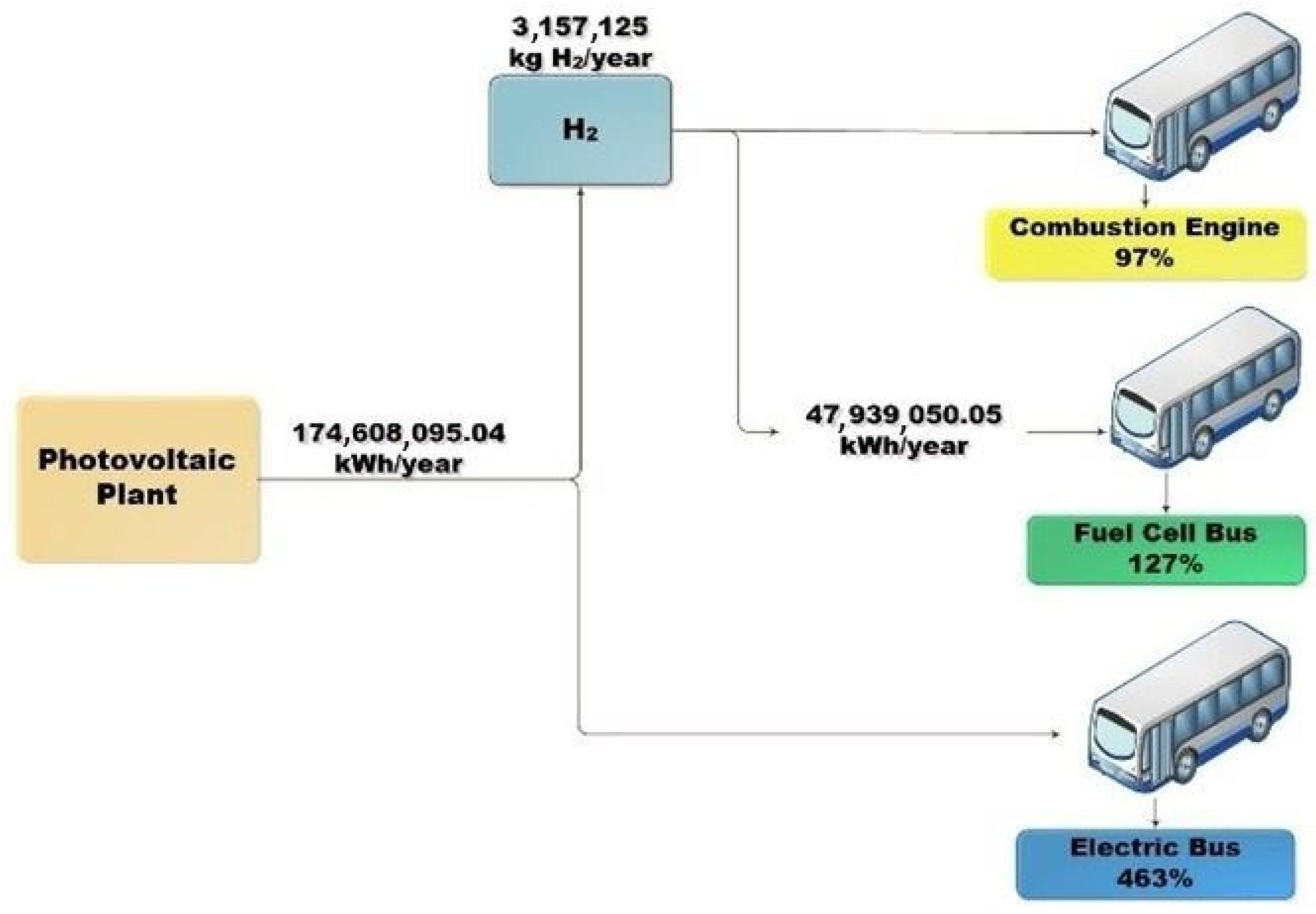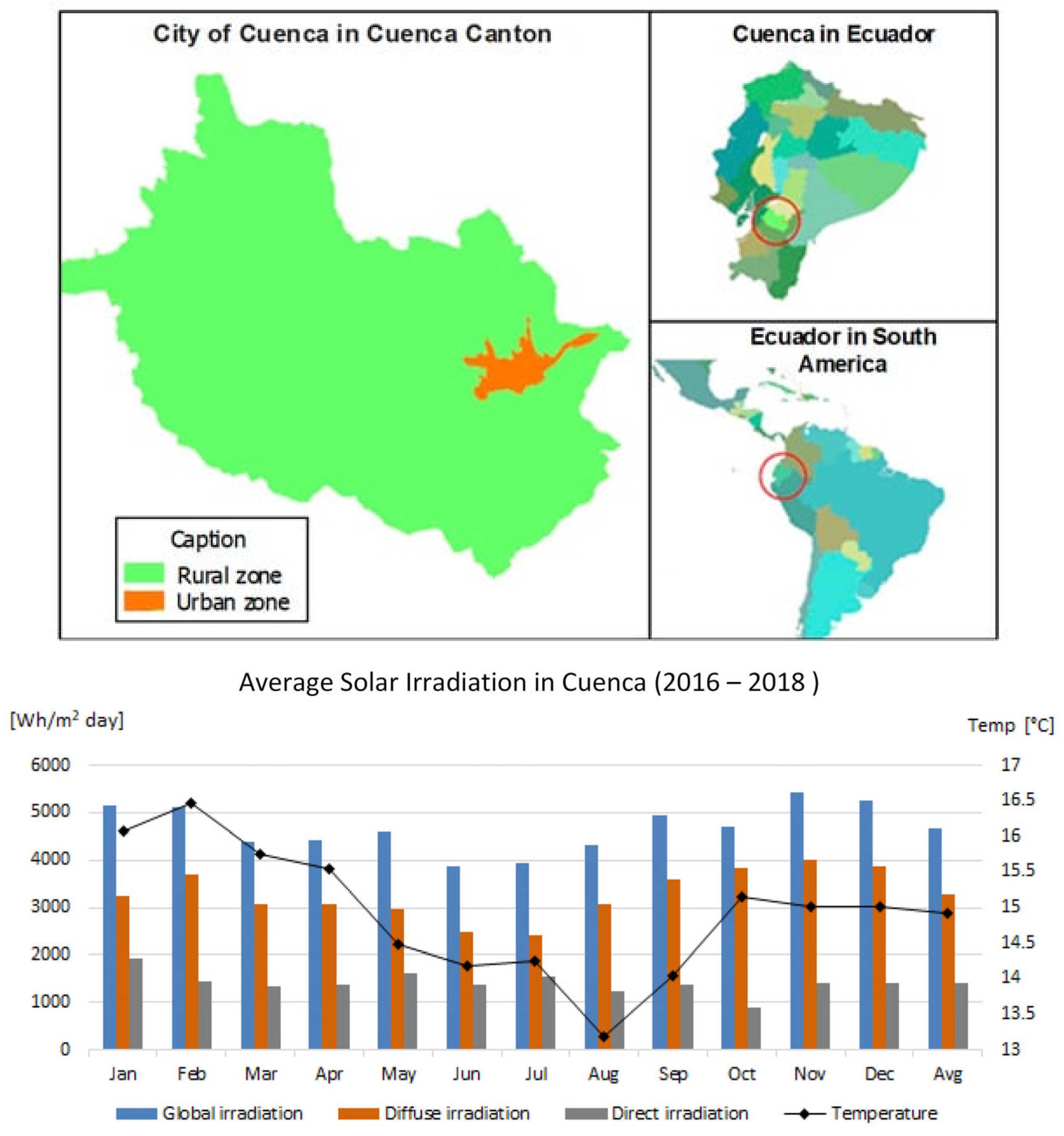Assessing the Feasibility of Hydrogen and Electric Buses for Urban Public Transportation using Rooftop Integrated Photovoltaic Energy in Cuenca Ecuador †
Abstract
1. Introduction
2. Materials and Methods
2.1. PV Solar Energy Potential in Urban Downtown Cuenca
2.2. Estimation of Usable Solar Energy
2.3. Technical Potential
2.4. Production of H2 from PV Exceeding
2.5. Hydrogen Buses
2.6. Fuel Cells
2.7. Direct Use of Electricity
3. Results
3.1. End Use for H2 for Bus Transportation
3.2. Hydrogen Buses
3.3. Fuel Cells
3.4. Direct Use of Power on Electric Buses
4. Discussion
- ▪
- They do not generate pollution, since they only generate water vapor when combusting.
- ▪
- Refueling time is short: 3 to 5 min.
- ▪
- Maintenance of H2 vehicles is minimal and cheaper compared to combustion ones.
- ▪
- H2 vehicles are silent and non-polluting.
- ▪
- The network of H2 service stations is under development.
- ▪
- Currently, there is not a wide variety of H2 vehicle models.
- ▪
- Fuel cell vehicles, due to their components, such as H2 tanks, lead companies to develop only quite large models.
5. Conclusions
Author Contributions
Funding
Data Availability Statement
Acknowledgments
Conflicts of Interest
References
- Bhattacharya, M.; Paramati, S.R.; Ozturk, I.; Bhattacharya, S. The effect of renewable energy consumption on economic growth: Evidence from top 38 countries. Appl. Energy 2016, 162, 733–741. [Google Scholar] [CrossRef]
- Scholten, D.; Bosman, R. The geopolitics of renewables; exploring the political implications of renewable energy systems. Technol. Forecast. Soc. Chang. 2016, 103, 273–283. [Google Scholar] [CrossRef]
- Barragán-Escandón, A.; Zalamea-león, E.; Terrados-Cepeda, J.; Parra-González, D. Las energías renovables a escala urbana. Aspectos determinántes y selección tecnológica. Bitácora Urbano Territ. 2019, 29, 39–48. [Google Scholar] [CrossRef]
- Barragán-Escandón, E.A.; Zalamea-León, E.F.; Terrados-Cepeda, J.; Vanegas-Peralta, P.F. Energy self-supply estimation in intermediate cities. Renew. Sustain. Energy Rev. 2020, 129, 109913. [Google Scholar] [CrossRef]
- Moles, R.; Foley, W.; Morrissey, J.; O’Regan, B. Practical appraisal of sustainable development-Methodologies for sustainability measurement at settlement level. Environ. Impact Assess. Rev. 2008, 28, 144–165. [Google Scholar] [CrossRef]
- Grewal, P.S.; Grewal, P.S. Can cities become self-reliant in energy? A technological scenario analysis for Cleveland, Ohio. Cities 2013, 31, 404–411. [Google Scholar] [CrossRef]
- Compagnon, R. Solar and daylight availability in the urban fabric. Energy Build. 2004, 36, 321–328. [Google Scholar] [CrossRef]
- Izquierdo, S.; Rodrigues, M.; Fueyo, N. A method for estimating the geographical distribution of the available roof surface area for large-scale photovoltaic energy-potential evaluations. Sol. Energy 2008, 82, 929–939. [Google Scholar] [CrossRef]
- Byrne, J.; Taminiau, J.; Kurdgelashvili, L.; Kim, K.N. A review of the solar city concept and methods to assess rooftop solar electric potential, with an illustrative application to the city of Seoul. Renew. Sustain. Energy Rev. 2015, 41, 830–844. [Google Scholar] [CrossRef]
- Lund, P. Large-scale urban renewable electricity schemes—Integration and interfacing aspects. Energy Convers. Manag. 2012, 63, 162–172. [Google Scholar] [CrossRef]
- Salpakari, J.; Mikkola, J.; Lund, P.D. Improved flexibility with large-scale variable renewable power in cities through optimal demand side management and power-to-heat conversion. Energy Convers. Manag. 2016, 126, 649–661. [Google Scholar] [CrossRef]
- Panchenko, V.A.; Daus, Y.V.; Kovalev, A.A.; Yudaev, I.V.; Litti, Y.V. Prospects for the production of green hydrogen: Review of countries with high potential. Int. J. Hydrogen Energy 2023, 48, 4551–4571. [Google Scholar] [CrossRef]
- Zalamea-León, E.; Mena-Campos, J.; Barragán-Escandón, A.; Parra-González, D.; Méndez-Santos, P. Urban Photovoltaic Potential of Inclined Roofing for Buildings in Heritage Centers in Equatorial Areas. J. Green Build. 2018, 13, 45–69. [Google Scholar] [CrossRef]
- Pelaez-Samaniego, M.R.; Riveros-Godoy, G.; Torres-Contreras, S.; Garcia-Perez, T.; Albornoz-Vintimilla, E. Production and use of electrolytic hydrogen in Ecuador towards a low carbon economy. Energy 2014, 64, 626–631. [Google Scholar] [CrossRef]
- Smink, V. Hidrógeno verde: 6 países que lideran la producción de una de las “energías del futuro” (y cuál es el único latinoamericano). BBC News Mundo 2021, 31, 1–16. [Google Scholar]
- Posso, F.; Sánchez, J.; Espinoza, J.L.; Siguencia, J. Preliminary estimation of electrolytic hydrogen production potential from renewable energies in Ecuador. Int. J. Hydrogen Energy 2016, 41, 2326–2344. [Google Scholar] [CrossRef]
- Posso, F.; Narváez, R.A.C.; Siguencia, J.; Sánchez, J. Use of Municipal Solid Waste (MSW)-Derived Hydrogen in Ecuador: Potential Applications for Urban Transportation. Waste Biomass Valorization 2019, 10, 1529–1537. [Google Scholar] [CrossRef]
- ARCONEL. Estadística Anual y Multianual del Sector Eléctrico Ecuatoriano 2019; Agencia de Regulación y Control de Electricidad: Quito, Ecuador, 2019. [Google Scholar]
- Barragán-Escandón, E.A. Generador Fotovoltaico Conectado a la Red Interna de Distribución Eléctrica Edificio Proyectado Para la Empresa Eléctrica Regional; CENTROSUR: Cuenca, Ecuador, 2020. [Google Scholar]
- Corporación para la Investigación Energetica Atlas Solar del Ecuador. Available online: https://biblioteca.olade.org/opac-tmpl/Documentos/cg00041.pdf (accessed on 17 July 2023).
- Revelo Vaca, D.; Ordóñez, F.; Villada López, J. Atlas Solar Ecuador. Available online: https://meteo-scinergy.epn.edu.ec (accessed on 17 July 2023).
- Ortiz, J.A.U.; Iñiguez, L.I.Y. Metodología Para el Calculo Área de Techos; Universidad de Cuenca: Cuenca, Ecuador, 2018. [Google Scholar]
- Barragán-Escandón, A.; Zalamea-León, E.; Terrados-Cepeda, J. Incidence of photovoltaics in cities based on indicators of occupancy and urban sustainability. Energies 2019, 12, 810. [Google Scholar] [CrossRef]
- Serrano-Guerrero, X.; Cantos, E.; Feijoo, J.J.; Barragán-Escandón, A.; Clairand, J.M. Optimal tilt and orientation angles in fixed flat surfaces to maximize the capture of solar insolation: A case study in Ecuador. Appl. Sci. 2021, 11, 4546. [Google Scholar] [CrossRef]
- Izquierdo-torres, I.F.; Pacheco-portilla, M.G.; Gonzalez-Morales, L.G.; Zalamea-Leon, E.F. Photovoltaic simulation considering building integration parameters. Ingenius 2019, 21, 9–19. [Google Scholar] [CrossRef]
- Serrano-Guerrero, X.; Alvarez-Lozano, D.; Romero, S.F.L. Influence of Local Climate on the Tilt and Orientation Angles in Fixed Flat Surfaces to Maximize the Capture of Solar Irradiation: A Case Study in Cuenca-Ecuador. In Proceedings of the 2019 IEEE International Autumn Meeting on Power, Electronics and Computing, ROPEC 2019, Ixtapa, Mexico, 13–15 November 2019; pp. 1–6. [Google Scholar]
- Zalamea-Leon, E.; Barragan-Escandon, A.; Mendez-Santos, P. Assessment of Photovoltaic Potential on Sloped Roofs on Ecuatorial-Andean Housing Typology. In Proceedings of the 2018 IEEE ANDESCON, Santiago de Cali, Colombia, 22–24 August 2018. [Google Scholar] [CrossRef]
- Khan, J.; Arsalan, M.H. Estimation of rooftop solar photovoltaic potential using geo-spatial techniques: A perspective from planned neighborhood of Karachi—Pakistan. Renew. Energy 2016, 90, 188–203. [Google Scholar] [CrossRef]
- Romero, L.; Duminil, E.; Ramos, J.S.; Eicker, U. Assessment of the photovoltaic potential at urban level based on 3D city models: A case study and new methodological approach. Sol. Energy 2017, 146, 264–275. [Google Scholar] [CrossRef]
- Schallenberg-Rodríguez, J. Photovoltaic techno-economical potential on roofs in regions and islands: The case of the Canary Islands. Methodological review and methodology proposal. Renew. Sustain. Energy Rev. 2013, 20, 219–239. [Google Scholar] [CrossRef]
- Luque, A.; Hegedus, S. Handbook of Photovoltaic Science and Engineering; John Wiley & Sons, Ltd.: Hoboken, NJ, USA, 2011. [Google Scholar]
- Barragán, E.A. El Autoabastecimiento Energético En Los Países En Vías de Desarrollo En El Marco Del Metabolismo Urbano. PhD Thesis, Jaen University, Caso Cuenca, Ecuador, 2019. [Google Scholar]
- Base de datos de la Energía Consumida en el 2020; Database; Empresa Eléctrica Regional Centrosur: Cuenca, Ecuador, 2020.
- Posso, F.; Espinoza, J.L.; Sánchez, J.; Zalamea, J. Hydrogen from hydropower in Ecuador: Use and impacts in the transport sector. Int. J. Hydrogen Energy 2015, 40, 15432–15447. [Google Scholar] [CrossRef]
- Barragán-Escandón, A.; Terrados-Cepeda, J.; Zalamea-León, E.; Arias-Reyes, P. Electricity production using renewable resources in urban centres. Proc. Inst. Civ. Eng. Energy 2018, 171, 12–25. [Google Scholar] [CrossRef]
- Martínez-Maldonado, V.; Barragán-Escandón, A.; Serrano-Guerrero, X.; Zalamea-Leon, E.F. Optimal routing for mass transit systems using multicriteria methodologies. Energy Strateg. Rev. 2023, 47, 101077. [Google Scholar] [CrossRef]
- Gonzalez-Longatt, F. Celdas de Combustible -Sistemas de Generacion Distribuida. Available online: https://www.researchgate.net/publication/298891826_Capítulo_24_Celdas_de_Combustible (accessed on 17 July 2023).
- Narváez, N.A.U. Análisis técnico-ambiental del uso de pilas combustibles de hidrógeno en el sector transporte. J. Chem. Inf. Model. 2021, 53, 6. [Google Scholar]
- Mekhilef, S.; Saidur, R.; Safari, A. Comparative study of different fuel cell technologies. Renew. Sustain. Energy Rev. 2012, 16, 981–989. [Google Scholar] [CrossRef]
- Lokar, J.; Virtič, P. The potential for integration of hydrogen for complete energy self-sufficiency in residential buildings with photovoltaic and battery storage systems. Int. J. Hydrogen Energy 2020, 45, 34566–34578. [Google Scholar] [CrossRef]
- Fletcher, T.; Ebrahimi, K. The effect of fuel cell and battery size on efficiency and cell lifetime for an l7e fuel cell hybrid vehicle. Energies 2020, 13, 5889. [Google Scholar] [CrossRef]
- Paredes, L.A. Electromovilidad y Eficiencia Energética en el Transporte Público de Pasajeros del Ecuador Continental. Rev. Técnica Energía 2019, 16, 97–105. [Google Scholar] [CrossRef]
- Parra, R. Inventario de Emisiones Atmosféricas Del Cantón Cuenca 2014, Cuenca, Ecuador. 2016. Available online: https://www.researchgate.net/publication/311789933_Inventario_de_Emisiones_Atmosfericas_del_Canton_Cuenca_2014 (accessed on 6 June 2023).
- Roncero, A. Emisiones de CO2: ¿qué Contamina Más, Un Gasolina o Un Diesel? Available online: https://www.auto10.com/reportajes/emisiones-de-co2-que-contamina-mas-un-gasolina-o-un-diesel/588 (accessed on 17 July 2023).
- Gómez, M. El hidrógeno Verde y la escasez hídrica. Hay agua para todos. Rep. Sosten. 2021. [Google Scholar]
- Muñoz-Vizhñay, J.P.; Rojas-Moncayo, M.V.; Barreto-Calle, C.R. Incentive Pertaining to Energy the Generation Distributed in Ecuador. Ingenius. Rev. Cienc. y Tecnol. 2018, 60–68. [Google Scholar]
- Plaza, D. El Hidrógeno En Los Coches: Ventajas e Inconvenientes. Available online: https://www.motor.es/que-es/hidrogeno (accessed on 17 July 2023).
- CNAE Vehículos de Hidrógeno: Cómo Funcionan, Pros y Contras. Available online: https://www.cnae.com/blog/index.php/vehiculos-hidrogeno-funcionan-pros-contras/ (accessed on 17 July 2023).



| Reduction Factors | Value | Source |
|---|---|---|
| Ccon | 0.9 | [27] |
| Cprot | 1 | [28] |
| Cso | 0.8 | [29] |
| Cor | 0.96 | [30] |
| Cin | 0.9 | [30] |
| CSM | 1 | [9,31] |
| CFV | 1 | [32] |
| CST | 1 | |
| FR | 0.62 | Equation (3) |
| PV Hydrogen Production | ||
|---|---|---|
| EPV | 174.61 | GWh |
| ne | 0.75 | |
| FD | 0.95 | |
| HHV Sup | 39.40 | kWh/kg |
| P H2 | 3,157,125.08 | kg |
| Battery Type | PEM | Fuente |
|---|---|---|
| Range temperature | 50–90 °C | [37] |
| Electrolyte | Membrane polymeric | [37] |
| Electrolyte status | Solid, which reduces corrosion and electrolyte management problems | [38] |
| Power | 100 W–10 MW | [37] |
| Fuel | H2 | [38] |
| Oxidizing | O2 | [38] |
| Catalyst | Platinum | [38] |
| Efficiency | 37–40%Average 38.5% | [38] |
| Investment cost | 3000–4000 USD/kWh | [37] |
| Cell voltage | 7–11 V | [39] |
| Application | Vehicles Space transportation | [37] |
Disclaimer/Publisher’s Note: The statements, opinions and data contained in all publications are solely those of the individual author(s) and contributor(s) and not of MDPI and/or the editor(s). MDPI and/or the editor(s) disclaim responsibility for any injury to people or property resulting from any ideas, methods, instructions or products referred to in the content. |
© 2023 by the authors. Licensee MDPI, Basel, Switzerland. This article is an open access article distributed under the terms and conditions of the Creative Commons Attribution (CC BY) license (https://creativecommons.org/licenses/by/4.0/).
Share and Cite
Cevallos-Escandón, A.; Barragan-Escandón, E.A.; Zalamea-León, E.; Serrano-Guerrero, X.; Terrados-Cepeda, J. Assessing the Feasibility of Hydrogen and Electric Buses for Urban Public Transportation using Rooftop Integrated Photovoltaic Energy in Cuenca Ecuador. Energies 2023, 16, 5569. https://doi.org/10.3390/en16145569
Cevallos-Escandón A, Barragan-Escandón EA, Zalamea-León E, Serrano-Guerrero X, Terrados-Cepeda J. Assessing the Feasibility of Hydrogen and Electric Buses for Urban Public Transportation using Rooftop Integrated Photovoltaic Energy in Cuenca Ecuador. Energies. 2023; 16(14):5569. https://doi.org/10.3390/en16145569
Chicago/Turabian StyleCevallos-Escandón, Antonia, Edgar Antonio Barragan-Escandón, Esteban Zalamea-León, Xavier Serrano-Guerrero, and Julio Terrados-Cepeda. 2023. "Assessing the Feasibility of Hydrogen and Electric Buses for Urban Public Transportation using Rooftop Integrated Photovoltaic Energy in Cuenca Ecuador" Energies 16, no. 14: 5569. https://doi.org/10.3390/en16145569
APA StyleCevallos-Escandón, A., Barragan-Escandón, E. A., Zalamea-León, E., Serrano-Guerrero, X., & Terrados-Cepeda, J. (2023). Assessing the Feasibility of Hydrogen and Electric Buses for Urban Public Transportation using Rooftop Integrated Photovoltaic Energy in Cuenca Ecuador. Energies, 16(14), 5569. https://doi.org/10.3390/en16145569









